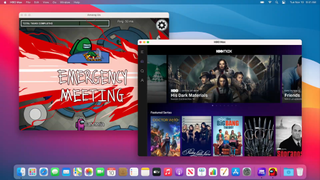
- #VMWARE FUSION MAC M1 CHIP HOW TO#
- #VMWARE FUSION MAC M1 CHIP INSTALL#
- #VMWARE FUSION MAC M1 CHIP REGISTRATION#
- #VMWARE FUSION MAC M1 CHIP SOFTWARE#
(Notice that my VM is labeled “Windows 10” - that was the current release when I first created the VM, and since it was an insider build, it has since upgraded to Windows 11.
#VMWARE FUSION MAC M1 CHIP INSTALL#
Once Windows 11 is installed, it will automatically install the Parallels Tools in the VM, to better integrate Windows 11 into your environment. And of course it can download and install various flavors of Linux as well. to meet the Windows hardware requirements. To run Windows 11, it does provide the expected virtual TPM 2.0 support, UEFI, Secure Boot, etc. It will even download the Windows 11 VHDX for you: Parallels goes out of its way to show Windows front-and-center, even though Microsoft barely supports this with a VHDX disk image of the latest ARM64 Windows 11 Insider Preview build. Next, you get a choice of OSes to install. As there can be a lot of confusion around what you can (ARM64) and can’t (Intel) emulate on an M1 Mac, Parallels needs to start with a screenful of information: You typically start off with a virtualization solution by creating a VM, so let’s start there. So what’s the difference? Let’s do a quick comparison.
#VMWARE FUSION MAC M1 CHIP SOFTWARE#
VMware then later released a tech preview for their own VMware Fusion software (free while in preview). Initially, the only option for running virtual machines on M1 Macs was Parallels Desktop, so that’s where I started. (You might think the first VM was a Windows VM, but that’s not the case, the first was a Fedora 34 Linux installation. Not surprisingly, the first thing I wanted to do on it was to run virtual machines.
#VMWARE FUSION MAC M1 CHIP REGISTRATION#
Once you've completed the registration and set up a Brightspace account, visit the Brightspace and log in with the new account to access licenses and download instructions.I have a Mac Mini with the original ARM-based M1 chip.
#VMWARE FUSION MAC M1 CHIP HOW TO#
Any research being performed using the software will be non-commercial in nature.Īfter your request has been approved, you will receive an email with a registration link and additional details on how to set up an account and obtain software licenses. * I acknowledge that this software will only be used for Academic purposes and will not be used for administrative or infrastructure purposes. Note:If being used for a purpose other than classwork, such as non-commercial research, also provide a reason for this request. *Additional Comments Include course number. Request AccessĬomplete the form below to request access to this service. Once licensing has expired, use the request form to extend access.

Eligibility & CostĮach VMware Academic Software Licensing Program product may be ordered once every 12 months. vSphere licenses provided under this program may not be used for desktop virtualization and contain CPU limitations. ** Infrastructure product licenses (e.g., vSphere, vCloud and related products only) are provided by the Academic Software Licensing Program for personal use in gaining hands-on experience with the products.
VMware vCenter 6.x and 7.x Server Standard Edition** VMware vSphere 6.x and 7.x Enterprise Plus Edition** Each student and faculty member may redeem one key per product per year of subscription: The store contains several popular VMware products. (For university administrative and infrastructure purposes or staff licensing, see the Enterprise License Agreement.) Included Software Students and faculty may also use the software for non-commercial research. The VMware Academic Software Licensing Program provides free downloads of many popular VMware products for use in science, technology, engineering, and math courses by students and faculty, as well as staff who are currently enrolled in classes.


 0 kommentar(er)
0 kommentar(er)
